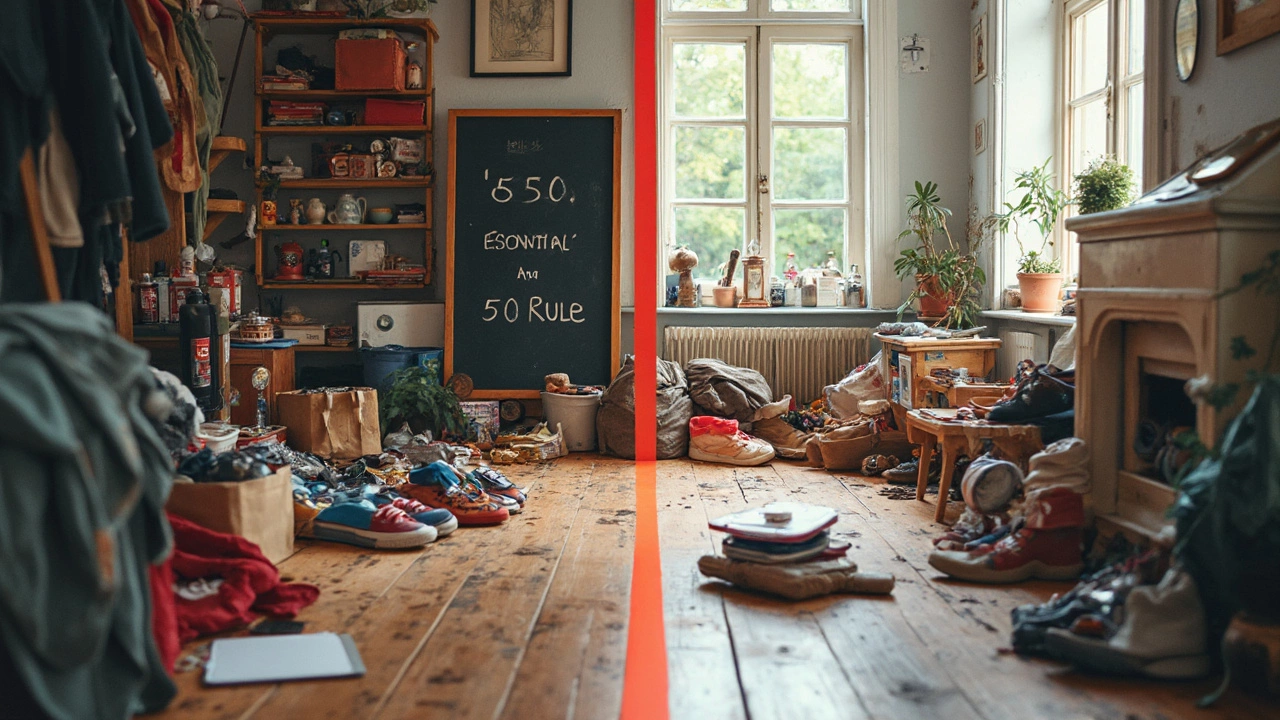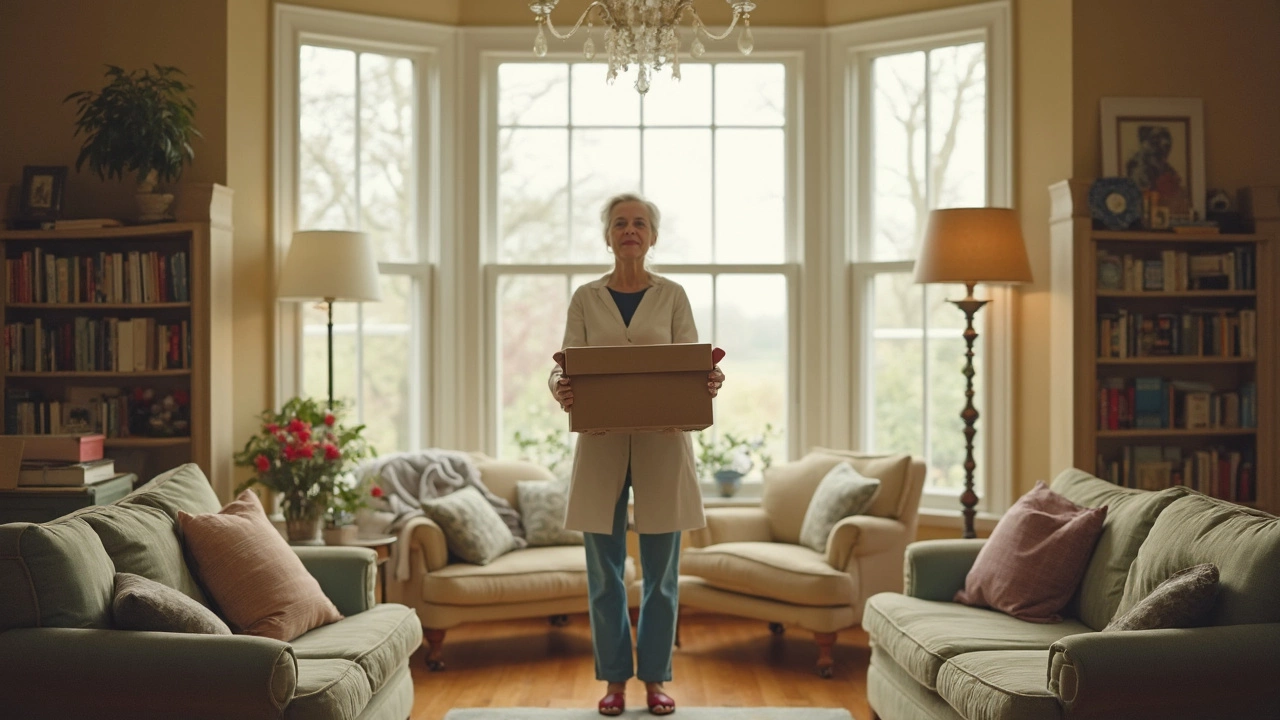Ever stare at your overflowing drawers and think, “How did I end up with so much stuff?” You’re not the only one. The 50 rule for decluttering isn’t magic, but it works like a reset button for your home. Here’s the simple idea: when you tackle any category—clothes, books, kitchen gadgets—you cut it down to just 50%. Keep half, donate or toss the rest.
This isn’t about turning into a minimalist overnight. It’s the fastest way to skip indecision and start fresh. Rather than overthinking every old hoodie or random Tupperware lid, you split things down the middle. It forces you to decide what you truly use and love, all in one go. Think of it as “decluttering on hard mode,” but that’s exactly why it works. Once you try it, you’ll be surprised by the extra space—and peace of mind—you’ll gain.
- What Exactly Is the 50 Rule for Decluttering?
- How to Apply the 50 Rule in Every Room
- Real-Life Tips for Making Tough Decisions
- What Happens After You Declutter With the 50 Rule?
What Exactly Is the 50 Rule for Decluttering?
The 50 rule for decluttering is as straightforward as it sounds: it’s about keeping only half of the items in any category or space. If you’ve got 30 mugs but only reach for the same four each week, it’s probably time to whittle that stash down to 15. The point isn’t to be extreme. Instead, it’s to create a clear, simple method that helps you clear space fast, wherever clutter piles up.
Here’s how the rule works in practice. First, pick one group—maybe your shirts or the mess of random beauty products under the bathroom sink. Count up your total items. Then, ruthlessly sort and keep only half. This rule skips the usual back-and-forth (“Should I keep this just in case?”) that slows most people down. And when you follow it, you don’t waste energy on little decisions that don’t matter. That’s why the 50 rule is suddenly a favorite among people who want a quick change with big results.
- It’s all about fast impact: By halving a collection, you get instant breathing room and less to manage.
- It’s not one-size-fits-all: If you really do use 10 pairs of jeans, adjust your numbers, but aim for a dramatic cut.
- The 50 rule can be separated by type: Try it for books, kitchen tools, towels—anything that crowds your space.
For a reality check, here’s what too much stuff looks like for many Americans, based on a 2023 study by the National Association of Productivity and Organizing Professionals:
| Category | Average Number Per Home |
|---|---|
| Clothing items | 92 |
| Books | 65 |
| Kitchen gadgets | 45 |
| Cosmetics/skincare | 38 |
The main benefit? Less clutter means less stress. When you only keep what matters, you spend way less time tidying, and it’s way easier to find (and enjoy) the things you really need.
How to Apply the 50 Rule in Every Room
Forget the idea that decluttering has to be dramatic or emotional. If your goal is less chaos and more space, the 50 rule can work just about anywhere in your home. Here’s a room-by-room breakdown of how to actually do it, with a few facts to keep things grounded.
- Living Room: Start with books, DVDs (yeah, people still have those), pillows, décor, and games. Gather each group in one spot so you can see exactly how many you have. For each category, grab only half to keep—the rest needs to go. The National Association of Productivity and Organizing Professionals found that over 30% of Americans admit their living room is the most cluttered space, so this is a good place to start.
- Kitchen: Raid your cupboards for duplicates or rarely used gadgets. Got three spatulas but only ever grab the same one? That’s an easy call. Unused appliances are storage hogs—let them go. Kitchens are often the worst for storing “just-in-case” items. According to a 2023 survey by SpareFoot, 47% of people keep kitchen stuff they haven’t touched in years.
- Closet/Bedroom: Dump everything out—we’re talking all your t-shirts, socks, shoes, you name it. Split them into keep and pull piles; you only get to keep half. If you haven’t worn something in a year, count it as an easy toss. On average, Americans only wear 18% of the clothes they own, so the rest just takes up space.
- Bathroom: Round up duplicates—think extra lotions, half-used bath bombs, five-year-old nail polish. See how much has expired or lost its appeal? Use the 50 rule to get ruthless. No one needs four bottles of nearly the same shampoo.
Here’s a simple table to show what’s actually typical in most homes versus what you’ll have after the 50 rule:
| Category | National Average Owned | Kept After 50 Rule |
|---|---|---|
| Books | 104 | 52 |
| Pairs of Shoes | 19 | 9-10 |
| Kitchen Gadgets | 23 | 11-12 |
| Throw Pillows | 8 | 4 |
The trick with the 50 rule is not to get distracted by what you “might” use one day. Focus on what you actually reach for week after week. If you’re stuck deciding over something sentimental, box it up and hide it for a month—if you forget it’s even there, you know it can go. This method isn’t about living with nothing; it’s about finally being able to enjoy—and actually find—the things you love.

Real-Life Tips for Making Tough Decisions
Let’s be real—the 50 rule for decluttering sounds simple, but when it’s time to put your stuff on the line, it gets tricky. Old gifts, the jeans you keep hoping will fit again, or that toaster oven you never use—they all make you pause. Here’s how to cut through the noise and get serious about what stays and what goes.
- Set a timer: Give yourself 30 minutes for each decluttering session. You make quicker, gut-based choices, and you won’t burn out.
- Sort first, decide later: Dump everything from one category in a pile (like all your mugs on the counter). It’s easier to see duplicates and pick your favorites when they’re all together.
- No backups allowed: If you keep backups "just in case," be strict. For most stuff—think spatulas or sweatpants—one or two is enough. As a rule, if you haven't used it in the last year, it probably doesn't deserve space.
- Reverse the closet trick: Hang all your clothes with hangers facing backwards. Flip a piece only when you wear it. After one month, it’s obvious what you’re using and what’s only taking up space.
- Ask the honest questions: Would you buy this again today? Was it ever worth the money? If the answer's no, it’s easier to let go.
On average, people use only about 20% of what’s in their closets, according to The National Association of Productivity & Organizing Professionals. Here’s a quick look at how unused stuff stacks up in a regular home:
| Item Category | Average % Unused |
|---|---|
| Clothing | 80% |
| Kitchen Gadgets | 60% |
| Books | 50% |
| Toys | 70% |
If you feel guilty about ditching something that was a gift or cost too much, remember: your peace of mind and space are more important. Try this—commit to donating the items that still work. Someone else could actually use what’s just gathering dust in your home.
Last tip? Bag it up and take it out the same day. Don’t let your “donate” pile become a new clutter zone. When each item has a clear destination, letting go gets a lot easier.
What Happens After You Declutter With the 50 Rule?
So you went all in with the 50 rule and got rid of half your stuff—now what? Honestly, most people are stunned by the ripple effect. You suddenly have more breathing room, less chaos, and cleaning takes half the time. Turns out, less stuff usually means less stress. When researchers at UCLA's Center on Everyday Lives and Families studied families, they found that people with cluttered homes tend to report higher stress levels, especially women. The benefits go beyond a tidy closet.
After editing your home with this rule, you’ll likely notice a few key things:
- 50 rule wins: You actually use what you keep. Most folks realize they rarely miss the things they let go—and if you do, it’s usually something replaceable, not sentimental.
- Easier storage: Cabinets and drawers close properly, and you can finally find your favorite spatula or that one phone charger without digging.
- Saving money: When you know what you own, you avoid buying duplicates. According to a 2023 survey by SpareFoot, almost 60% of Americans have rebought something they already owned but couldn’t find.
- Ready for real life: Hosting friends or family is less chaotic. You don’t have to stash piles in a closet right before someone rings the doorbell.
Some people even sleep better in a clutter-free bedroom. The National Sleep Foundation found that people with clean rooms are over 60% more likely to get a good night’s sleep. A tidy home clearly isn't just for looks—there’s real science behind why it feels good.
| Category | Before (Cluttered) | After (50 Rule) |
|---|---|---|
| Time Spent Cleaning Weekly | Up to 8 hours | 3–4 hours |
| Living Space Available | Crowded, hard to move | Open, organized |
| Money Lost on Duplicate Purchases | $200–$400/year | $50–$100/year |
| Mental Stress | High | Noticeably lower |
Last thing? More time for things you like, less time tidying. The 50 rule doesn’t just clear stuff—it makes space for living.


